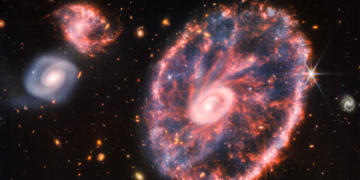For decades, astronomers have theorized that galaxies are not scattered randomly across the universe but are instead arranged in a vast interconnected structure called the cosmic web. This enormous network of dark matter and gas filaments serves as the scaffolding upon which galaxies form and evolve. However, directly imaging these cosmic filaments has remained a monumental challenge—until now.
What is the Cosmic Web?
The universe is far from empty. Instead, it is shaped by a vast, interconnected structure known as the cosmic web—a complex network of filaments made of dark matter and gas. These filaments guide the formation of galaxies, acting as cosmic highways that funnel matter into galaxies and their central supermassive black holes.
The Role of the Cosmic Web in Galactic Evolution
- Galaxies form and evolve within these filaments, receiving a steady flow of gas that fuels star formation.
- Dark matter, the invisible mass that makes up about 85% of the universe’s total mass, forms the foundation of these filaments, pulling in gas and other materials.
- The cosmic web’s structure was first predicted through supercomputer simulations, but observing it directly has remained one of the greatest challenges in modern cosmology.
Until recently, detecting these elusive filaments has been nearly impossible because the gas contained within them is extremely faint and difficult to observe. This new discovery changes that.
How Was This 3-Million-Light-Year Filament Detected?
Observing the cosmic web is a daunting task because most of it consists of dark matter, which does not emit or reflect light. The gas that flows through these filaments emits only a faint glow, making it difficult to detect.
Cutting-Edge Technology Makes the Invisible Visible
To overcome these challenges, astronomers used the Multi Unit Spectroscopic Explorer (MUSE) instrument, mounted on the Very Large Telescope (VLT) in Chile. MUSE is one of the most advanced instruments for capturing faint astronomical signals, allowing scientists to detect the glow from hydrogen gas within the cosmic web.
- Hundreds of hours of observations were required to capture the faint emission of hydrogen gas.
- The researchers analyzed the light that had traveled for nearly 12 billion years to reach Earth.
- The observations were then compared with cosmological simulations, confirming that the detected structure aligns with the predictions of the Lambda Cold Dark Matter (LCDM) model, the leading theory of the universe’s evolution.
A Breakthrough in Cosmic Cartography
By imaging this filament, scientists have for the first time been able to trace the boundary between galactic gas and cosmic web material. This discovery serves as a direct confirmation of how galaxies acquire their building blocks through the intergalactic highways of the cosmic web.
Why Is This Discovery So Important?
1. Validating the Standard Model of Cosmology
For decades, simulations have predicted that galaxies are connected by cosmic filaments, but these predictions lacked direct observational evidence. This discovery confirms that the LCDM model correctly describes the large-scale structure of the universe, reinforcing our understanding of dark matter and galaxy formation.
2. Shedding Light on Galactic Feeding Mechanisms
The observed filament acts as a cosmic pipeline, delivering gas to two actively forming galaxies. This process:
- Fuels star formation, explaining how early galaxies grew rapidly.
- Provides insights into how supermassive black holes at galactic centers are fed.
- Helps scientists understand why some galaxies experience intense growth spurts while others do not.
3. Enhancing Our Understanding of Dark Matter
While dark matter itself remains invisible, its gravitational influence on gas filaments can now be mapped more effectively. By identifying and studying more cosmic filaments, researchers can:
- Refine our estimates of how dark matter is distributed in the universe.
- Test alternative theories of gravity and cosmology.
4. Opening a New Era of Cosmic Web Exploration
This discovery marks only the beginning of cosmic web mapping. As astronomers gather more data, they aim to create a comprehensive 3D map of the cosmic web, offering new insights into how galaxies, dark matter, and intergalactic gas interact.
What’s Next? Searching for More Cosmic Filaments
While this discovery is monumental, scientists have only scratched the surface of what lies within the cosmic web. Next steps include:
- Expanding Observations: Astronomers plan to observe more regions of the sky using instruments like MUSE, as well as future telescopes like the Extremely Large Telescope (ELT).
- Refining Simulations: By comparing more observations with supercomputer simulations, researchers can fine-tune our models of cosmic evolution.
- Exploring the Role of Quasars: Since some cosmic filaments are illuminated by quasars (extremely bright black holes), future studies will investigate how quasars influence their surrounding cosmic web structures.
Conclusion: A New Perspective on the Universe’s Architecture
This direct observation of a 3-million-light-year filament of the cosmic web represents a major breakthrough in our quest to understand how the universe is structured and how galaxies grow. By capturing the faint glow of intergalactic gas, scientists have provided the first high-definition map of a cosmic filament, confirming long-standing theoretical predictions.
Reference:
High-definition imaging of a filamentary connection between a close quasar pair at z = 3

















